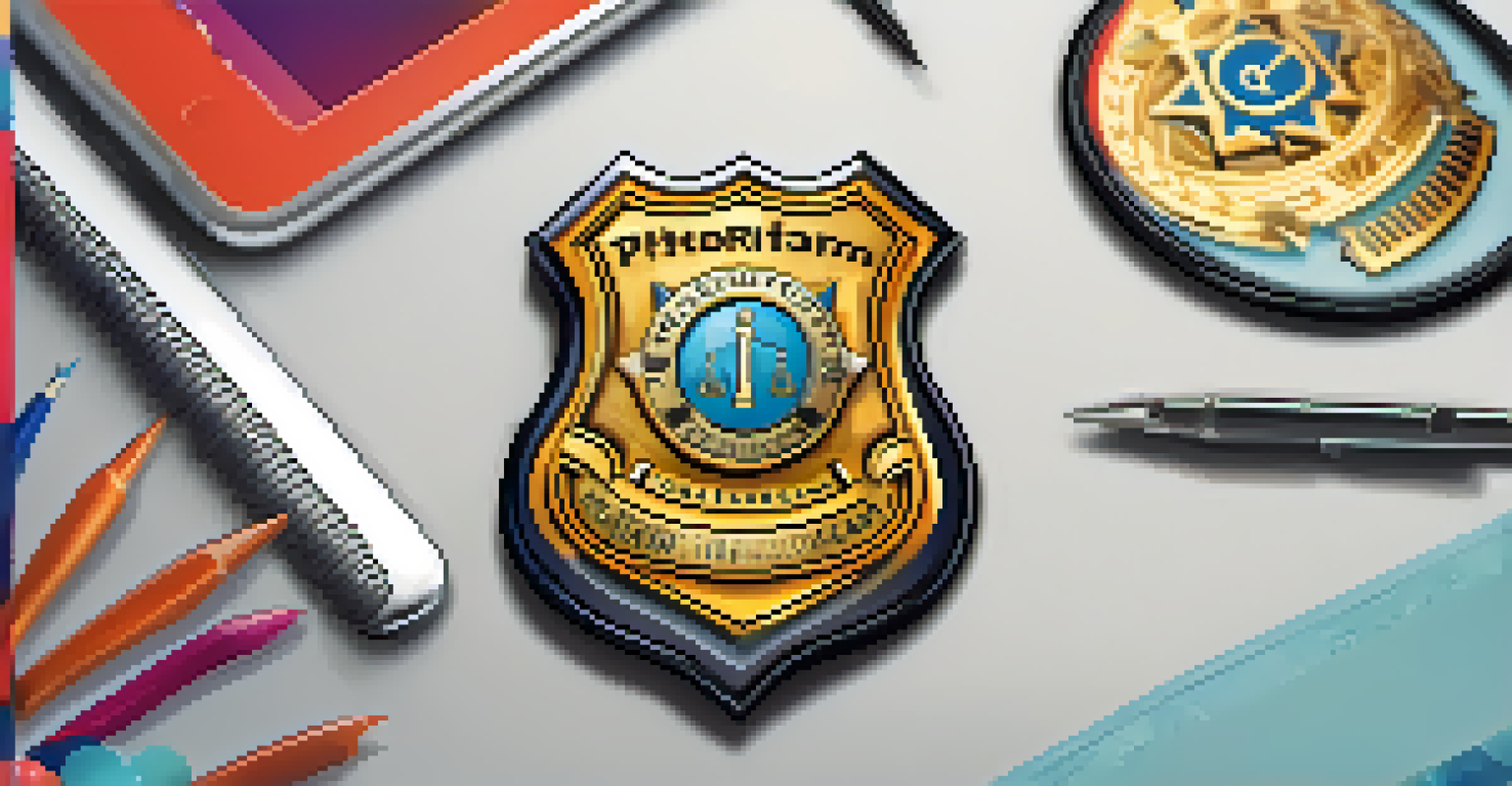The Impact of Badging on Adult Learning and Career Paths

Understanding Badging in Adult Learning Contexts
Badging is a digital credential that signifies the achievement of specific skills or knowledge. In adult learning, it acts as a motivator, encouraging individuals to pursue new skills and complete educational programs. Just like earning a merit badge in scouting, badging provides a tangible acknowledgment of accomplishments, making learning pathways more rewarding.
Badges help learners recognize their progress and set future goals.
This system has gained traction in various educational settings, from online courses to corporate training programs. By offering visual representations of skills, badging helps learners recognize their progress and set future goals. It transforms learning into a more interactive experience, where achievements are celebrated and shared.
Moreover, badging can bridge the gap between formal education and real-world skills, helping employers identify qualified candidates. In an increasingly competitive job market, these digital badges can provide an edge, showcasing a learner's commitment to professional development.
The Role of Badges in Motivating Adult Learners
Motivation can often be a hurdle for adult learners, who juggle multiple responsibilities. Digital badges can serve as powerful motivators by providing clear goals and milestones. When learners see a badge as a reward for their hard work, it reinforces positive behavior and encourages them to keep pushing forward.

For example, a marketing professional might earn a badge for completing a digital marketing course, which not only increases their knowledge but also boosts their confidence. This recognition can be crucial, especially for those returning to education after a long break. It creates a sense of accomplishment, validating their effort and time investment.
Badging Motivates Adult Learners
Digital badges serve as powerful motivators by providing clear goals and celebrating achievements, which encourages adult learners to pursue further education.
In addition, the social aspect of badging—where learners can share their badges on platforms like LinkedIn—can further fuel motivation. This public acknowledgment can foster a sense of community, encouraging others to pursue their learning journeys, too.
How Badges Enhance Skill Recognition for Employers
In today’s job market, employers are increasingly looking for specific skills rather than traditional degrees. Badges offer a straightforward way to showcase these skills in a visual format, making it easier for hiring managers to assess candidates. Rather than sifting through resumes, they can quickly identify individuals who have the relevant competencies.
In a world that’s constantly evolving, staying relevant requires ongoing education and adaptation.
For example, an IT professional with badges in cybersecurity and cloud computing can immediately demonstrate their expertise without needing lengthy explanations. This clarity benefits both the job seeker and the employer, streamlining the hiring process and reducing ambiguity around qualifications.
Moreover, badges can help establish a common language between educators and employers. As more organizations adopt this credentialing system, it creates a standardized way to convey skills and achievements, facilitating better communication about what candidates bring to the table.
The Lifelong Learning Approach Supported by Badging
Badging aligns perfectly with the concept of lifelong learning, encouraging adults to continually update their skills. In a world that’s constantly evolving, staying relevant requires ongoing education and adaptation. Badges serve as a roadmap, guiding learners on their journey of personal and professional growth.
For instance, a healthcare worker might pursue additional badges in telemedicine or patient care technologies, ensuring they remain competitive in a rapidly changing field. This approach not only benefits individuals but also enhances the overall quality of the workforce in various industries.
Employers Value Digital Badges
In the evolving job market, badges provide a visual representation of specific skills, making it easier for employers to identify qualified candidates.
Additionally, lifelong learning supported by badging fosters a growth mindset. Learners begin to see education as an ongoing process rather than a finite journey, cultivating curiosity and a desire for continuous improvement.
Challenges and Criticisms of Badging Systems
While badging has many benefits, it’s not without its challenges. One common criticism is the potential for badge inflation, where the value of badges diminishes due to over-saturation. If everyone has a badge for every little achievement, it may become difficult to distinguish between meaningful accomplishments and trivial ones.
Another challenge is ensuring the quality and rigor behind the badges. Not all badges are created equal; some might represent a significant skill, while others may be awarded for minimal effort. This inconsistency can lead to confusion among employers and learners alike.
To combat these issues, it’s crucial for organizations to establish clear standards and criteria for issuing badges. Quality control measures, such as peer reviews or endorsements from industry leaders, can help maintain the integrity of the badging system.
Integrating Badges into Traditional Learning Frameworks
Integrating digital badging into traditional educational frameworks can enhance the learning experience. By coupling badges with conventional grading systems, educators can provide a more comprehensive view of a learner’s progress. This integration allows for a more holistic understanding of skills and achievements.
For example, a university might award badges for completing specific projects or engaging in community service, in addition to grades for exams. This multifaceted approach recognizes diverse forms of learning and encourages active participation beyond the classroom.
Lifelong Learning and Badging
Badging aligns with lifelong learning by encouraging adults to continuously update their skills, fostering a growth mindset in today's fast-paced world.
Furthermore, integrating badges can promote collaboration between educational institutions and industry partners. By aligning badges with industry standards, educators can ensure that learners are acquiring the skills most relevant to employers, creating a more seamless transition from education to the workforce.
Future Trends: Badging in the Evolving Job Market
As the job market continues to evolve, the use of badging is likely to expand. With the rise of remote work and digital platforms, more professionals will seek to demonstrate their skills through recognizable credentials. Badging could become a norm, not just an option, in the hiring process.
Moreover, advancements in technology may lead to more sophisticated badging systems, incorporating elements like blockchain for secure verification. This could further enhance the credibility of badges, making them a trusted resource for both employers and learners.

Ultimately, as we embrace this shift toward skills-based hiring, badging will play a vital role in shaping the future of education and career development. By adapting to these trends, adults can better navigate their career paths and continue to grow in their fields.